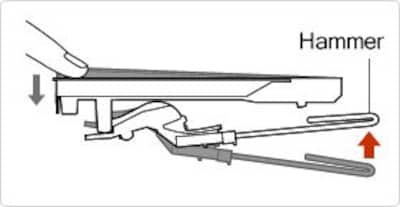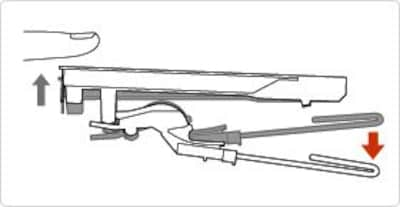Acoustic or Digital?
The Main Difference Is the Mechanism that Produces the Sound
The main difference between a piano (a standard acoustic piano) and a digital piano is the mechanism that produces the sound.
The piano produces sounds by channeling the power of the fingers pressing the keys into the hammers, which strike the strings. The vibrations produced by striking the strings are transmitted to the soundboard, and diffused richly, which amplifies the sound. When these vibrations combine with the resonances of strings other than the ones that were struck, it creates a unique sound.
In contrast, the digital piano has no strings. Each key is a switch to produce a specific sound, so to speak. An electronic tone generator produces the sounds, which are amplified using a speaker.
Digital pianos made by Yamaha are equipped with hammers, though. These are not for the purpose of striking the strings, as with an acoustic piano, but instead are employed to capture the dynamics with which the key is played, yielding a dynamic response to touch that more closely approximates the experience of playing an acoustic piano.
* The diagram below shows the hammer action of the Clavinova (GH/GH3/NW keyboard).


When the key is depressed: The hammer rises sharply for a touch response comparable to that of a piano.
When the key is released: The key returns to its resting position naturally under the weight of the hammer.
Example performances using digital pianos
A Digital Piano that Comes Close to an Acoustic Piano
In an acoustic piano, the tone varies infinitely according to the pianist's touch. It is an instrument that can bring out emotions by playing musical pieces with great expressiveness.
At the same time, advances in technology have made it possible for digital pianos to reproduce sounds very close to those of an acoustic piano, and even the feel of the keyboard can be closely simulated by various mechanisms.
Features
Acoustic Piano:
A highly sophisticated instrument developed throughout the long history of piano music. An appealing, pure sound with a spontaneous and rich musical quality derived from the resonance and harmonics of the strings. Allows limitless musical expression, in accordance with how the instrument is played.
Digital Piano:
Lightweight, compact and requiring no tuning, with volume control. Ability to simulate the timbres of a variety of musical instruments in addition to a piano sound that closely approximates the expressive qualities of an acoustic piano, with built-in recording functionality.
Sound producing mechanism
Acoustic Piano:
A string-striking mechanism, referred to as the action, generates a vibration that is transmitted to the soundboard via the frame. As the entire instrument acts as a resonator, a rich and full quality of sound is produced.
Digital Piano:
Sensors can detect the most delicate movements of the keys, digitally recorded sound from a grand piano can be amplified and produced from speakers. Can use acoustic effects, including reverb and the acoustic environment of performing in a large space, using digital technology.

Touch
Acoustic Piano:
The string-striking mechanism, referred to as the "action" and composed of around 5,500 individual precision parts, convey the subtle nuances of finger movement to the hammer. Intuitive response to touch.
Digital Piano:
A variety of mechanisms employed in the pursuit of reproduction of a grand piano touch response.
Keyboard touch response varies according to manufacturer and model.
Tone
Acoustic Piano:
Timbre and sound quality varying according to how the instrument is played, due to the complex effect of resonance in strings not directly struck. This offers the pianist abundant expressive potential.
Digital Piano:
Consistent timbre for all pianists.
Consistent timbre and volume where keys are played with the same strength.
Expressive power
Acoustic Piano:
Acoustic pianos are musical instruments that can sustain notes over a long period, from the note beginning to sound to when it fades. Depending on the strength or softness of touch, not only the volume but also the timbre, from mellow to brilliant, affords a rich expressive potential.
Digital Piano:
Using extensive, detailed recordings of sounds of acoustic pianos, and technology that smooths the transition between timbres produced in response to firm or gentle touch, approaches the expressive capabilities of an acoustic piano.
Durability
Acoustic Piano:
Can be used over a long timeframe by replacing worn parts and doing periodic adjustments.
Digital Piano:
Depends on standards for the expected lifetime of electronic components.
Musical Instrument Guide : Piano Contents
Origins
Structure
How to Play
How the Instrument is Made
Choosing an Instrument
Care and Maintenance
Trivia
- The White Keys and Black Keys Were Reversed on Pianos in Mozart's Day
- Did Mozart's Piano Have a Pedal-Board?
- Piano with Automatic Accompaniment System in Beethoven's Day
- The Pianos Beloved by the Great Master, Sviatoslav Richter
- The Optimal Material for Piano Frames Is Also Ideal for Motorcycle Engines
- The Piano Soundboard Is a Board that Also Stops Vibrations
- Why Can't There Be More Than 88 Keys on a Piano?
- Why a Grand Piano Keyboard Feels Heavier Than an Upright Keyboard?
